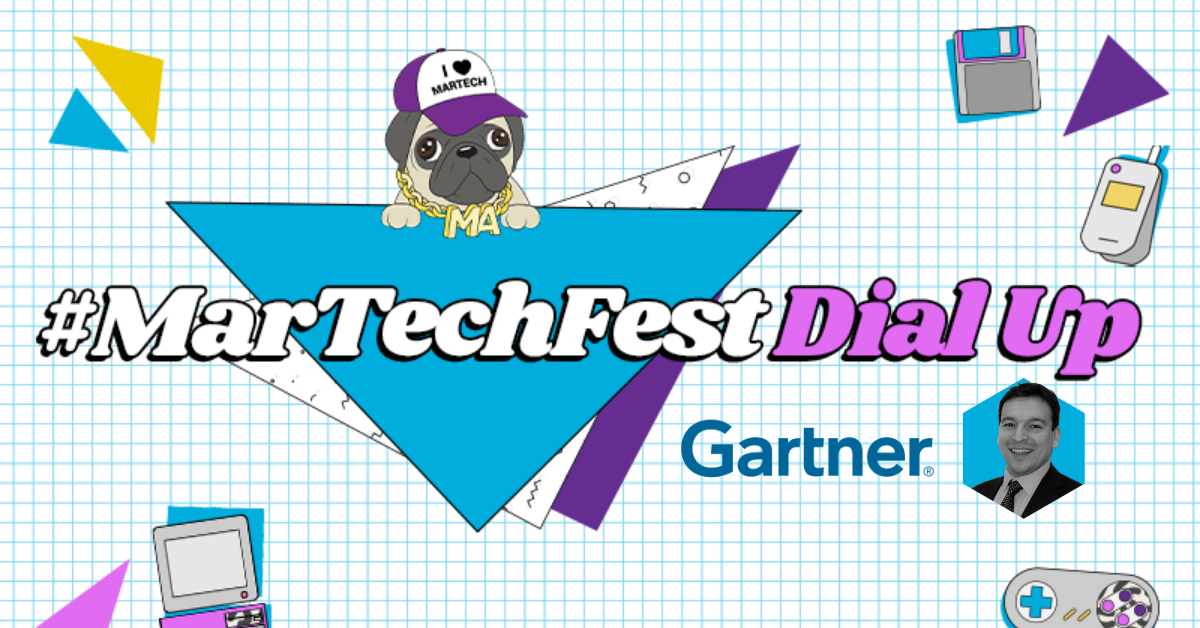Gartner Kicks off Dial Up with a Bang.

Personalisation is a hot topic in the martech space right now. With more and more customer data at our fingertips, the question is sparked – “How do we utilise this data to communicate with our customer effectively?”
Our good friend, Alex de Fursac Gash, Senior Director and Analyst from Gartner, reveals that when it comes to personalisation, less is more.
Alex kicked off our #MarTechFest Dial Up Series 2 with a bang as he brought us his brilliant live session titled: “How Personalisation Efforts Can Help Customer Experience… But Also Worsen it.”
If you didn’t catch the live sesh, we’re not angry, just disappointed… But we simply could not sleep at night knowing you’ve missed out on such an insightful session.
So, we present to you: the power of the write up. Covering the top facts and stats to sink your teeth in to (Albeit delivered with a little less charisma and charm, but we’ll do our best.)
The key topics covered:
- What does great personalisation look like?
- How do we operationalise our personalisation efforts?
- How to adapt our martech stack to meet our personalisation needs?
Are you sitting comfortably? Then we’ll begin…
Let’s take it from the very beginning. What do we really mean when we say “personalisation”? The definition Alex gave us was this: “Personalisation is the practice of gathering and analysing customer data to deliver a tailored interaction between the brand and the customer.” At its core, personalisation comes in the form of 2 deliverables: Content production and Message delivery.
Effective personalisation has the power to:
- Capture your customer’s attention and cut through the noise.
- Deepen your relationship with your customer base
- Drive conversion
So, it’s no surprise that the topic of personalisation is at the forefront of the industry’s attention. But executing personalisation and executing personalisation effectively, are two very different matters.
In fact, a survey conducted by Gartner found that over personalisation can be even more detrimental than under personalisation when it comes to your customer retention and loyalty.
Specifically, the survey found that an email with no personalisation, made up of irrelevant messaging to the recipient resulted in 12% of the audience ending their business with the company.
However, an email with over personalisation, with messaging containing extremely specific facts and insights about the recipient resulted in 38% of the audience ending their business with said company.
That’s right. Let that shiver crawl up your spine as the enormity of that percentage sinks in.
Yes, the only thing more detrimental to under personalising your messaging with your customer, is over personalising.
Here we shall pause for dramatic effect as the panic begins to loom…
Okay. Panic over. Luckily, Alex doesn’t leave us high and dry and the research continues…
Gartner conducts further research into customer perceptions of personalised messaging and defines the results of being in one of two categories:
- The brand-centric: “Prove you know me”
This is where brands like to show just how clever and (supposedly) attentive they are, that they (often unsubtly) mention personal information such as past behaviours and personal values in attempt to connect with the customer.
2. The customer-centric: “Help me”
This is where the brand uses the customer data to understand the potential difficulties that the customer may be facing. For example, making it easier for the customer to complete a purchase, reassure and help the customer feel less anxious about the purchasing decision or teach something new, helping the customer to better understand the product.
Unsurprisingly, Gartner’s research suggests that “Help me” messaging is much more effective. When including personalisation into your messaging, don’t try and personalise, try and help.
So now we know how to personalise effectively, how do we operationalise our personalisation efforts?
The martech gods (and Gartner) have blessed us with this simple 3-step guide:
- Identify the need for help
- Design the help
- Tailor the help
It’s at step 3 that we can bring a sprinkling of personalisation to increase the effectiveness of our messaging. However, we must remember that personalisation should be used to define our messaging but not drive it.
Of course, personalisation, particularly at scale, requires the right stack. Alex shares with us 4 overlapping sets of capabilities for personalisation:
- Data – the ability to gather 1st, 2nd and 3rd party data
- Analytics – Both basic and advanced analytics are required to build customer and audience segments
- Engine – To apply rules to AI to test, target, trigger and tailor content
- Execution – To receive the trigger and present an adapted message or customer experience
How you infuse these capabilities together will depend on your goal. However, it’s likely that you will find a common denominator in most goals – a CDP.
Alex suggests that Customer Data Platforms will serve as a critical tool in serving best-in-class personalisation as ‘accepted’ messaging and customer behaviour will always evolve, therefore, the need for a CDP will be even more paramount.
To find more sessions on CDPs, Customer Journeys and more grab your pass to #MarTechFest Dial Up for one whole month of binge-worthy martech.

